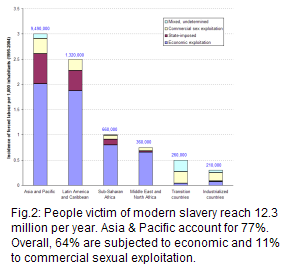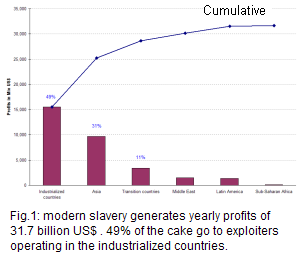
|
Insight : modern slavery |

|
|
You are here: areppim > Society > Modern slavery
Modern slavery: a lucrative business

 Slavery-like practices, which include forced labour, are alive and well. In fact they thrive with the economic globalization of today's world. Cautious estimates by the International Labour Office (ILO) suggest that the total profits derived from modern day slavery reached US$ 32 billion in 2005. A juicy 49% or US$ 15.5 billion have been cashed by profiteers in the industrialized countries, although this group of countries only account for 2.9% of the number of people subjected to those vilifying practices (see enlarged figure 1).
Slavery-like practices, which include forced labour, are alive and well. In fact they thrive with the economic globalization of today's world. Cautious estimates by the International Labour Office (ILO) suggest that the total profits derived from modern day slavery reached US$ 32 billion in 2005. A juicy 49% or US$ 15.5 billion have been cashed by profiteers in the industrialized countries, although this group of countries only account for 2.9% of the number of people subjected to those vilifying practices (see enlarged figure 1).
Despite attempts to put an end to slavery (see Glossary for definition), new forms of forced labour (see Glossary for definition) and slavery-like practices are "present in some form on all continents, in almost all countries, and in every kind of economy" says the ILO report.
The global number of victims reaches a minimum of 12.3 million people, maybe as many as 14.8 million (see enlarged figure 2). This magnitude compares with the estimated 12 million Africans shipped as slaves to the American shores or the 17 million dragged to Middle East and other oriental countries in the course of 4 centuries. Forms of forced labour vary according to the region. Overall, 63% of modern slaves are channelled to economic exploitation, and 11% to commercial sexual exploitation. As a whole, 80% fall under the grip of private persons; the remaining 20% are victims of the state or military authorities.
The difficulty of effectively attacking the phenomenon stems from several factors:
- Governments are sometimes reluctant to admit its existence and probe into it;
- Victims are afraid of speaking up for fear of punishing reprisals from exploiters, and maybe even more of administrative action by law enforcement or immigration officials;
- Deregulation of the labour market and the accompanying downsizing of labour inspections create business opportunities for little-scrupulous labour contractors, gangmasters, human traffickers and other "snakeheads";
- New communication and transportation technologies increase the complexity of the networks involved in fostering and exploiting modern day slavery.
Legislation against illegal immigration has perverse effects. On one hand, it stimulates criminal minds to develop clandestine networks for smuggling or trafficking human beings. In doing so, traffickers respond to the aspirations of would-be migrants to escape poverty and find work abroad, and provide a service to business managers in need of cheap labour willing to take "3-D" (dirty, difficult, dangerous) jobs that nobody else would accept. On the other hand, strict legislation ends up putting a lid on the free expression of the victims who cannot but wonder what is worse, being exploited or risking deportation.
It is ironic that, in times of so much babble talk about human rights, so many fellow humans find themselves entirely destitute of any rights at all. If someone commits a larceny, the judiciary system will acknowledge her rights, listen to her case, ponder, pronounce the verdict, and eventually reinstate that person into society. However, an illegal immigrant, whose only crime consists of being a victim of slavery-like practices, cannot ever expect such a "just" treatment.
Far from being the dignified "homo faber" they are supposed to be as human beings, modern slaves are in fact reduced to the infra-human condition of "animal laborans" (working animal).
[Source: ILO - International Labour Organization: "A global alliance against forced labour - Global Report under the Follow-up to the ILO Declaration on Fundamental Principles and Rights at Work", ILO, Geneva, 2005.]
Download


 Go toTop
Go toTop
 Home
Home